NIOSH: Communications Failures Often Factor in LODD Incidents
Communication failures are often listed by NIOSH investigators as a key contributing factor in line-of-duty firefighter deaths.
Lack of training, equipment issues, and ineffective procedures have contributed to these deaths, according to a NIOSH report.
They say it's imperative that all firefighters and dispatchers understand how to effectively use their radio equipment.
"Communication failures are predictable and preventable. Fire departments and municipalities should make sure firefighters and dispatchers complete and have ongoing training to use their radios effectively." investigators noted.
"Educate your team about communication failures. Look at all five categories of communication failures for improvement opportunities to help keep your team safe."
Firefighter communication failures generally fall into five main categories. They include personnel, equipment, policy and procedures, environment and leadership and management.
They said the wrong equipment for the job, or a poor design leads to failures or ineffective operations. Examples include radio component failures from heat exposure, the volume knob rotating freely causing the volume to drop too low to hear, or the channel knob rotating freely placing the radio on the wrong channel.
Investigators determined that many departments are lacking policies and procedures on training, use and maintenance.
It's vital for firefighters to know how extreme conditions can cause radio malfunctions.
They also noted in the report that firefighters should activate the emergency alert button (EAB) on their radio anytime that they are in distress and need assistance. Activating the EAB:
- Notifies everyone on the fireground, and with dispatch, that a firefighter needs emergency assistance. This guarantees everyone is notified even if the firefighter is not able to key their mic and speak.
- Provides the firefighter with priority transmissions on the radio system. This guarantees that critical radio transmissions are heard over other transmissions.
About the Author
Firehouse.com News
Content curated and written by Firehouse editorial staff, including Susan Nicol, Peter Matthews, Ryan Baker and Rich Dzierwa.
